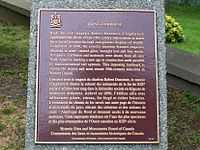Craigdarroch Castle
| Craigdarroch Castle | |
|---|---|
 | |
 Location in British Columbia
| |
| Established | 1890 (construction), 1979 (museum) |
| Location | 1050 Joan Crescent Victoria, British Columbia, CANADA |
| Coordinates | 48°25′21″N 123°20′37″W / 48.422585°N 123.343704°W |
| Type | historic house museum (Victorian era) |
| Visitors | 150,000 per year |
| Public transit access | Victoria Regional Transit System #11 and #14 bus |
| Website | www.thecastle.ca |
| Official name: Craigdarroch National Historic Site of Canada | |
| Designated: | 1992 |
Craigdarroch Castle in Victoria, British Columbia, is a historic, Victorian-era Scottish Baronial mansion. The mansion was designated a National Historic Site of Canada due to its landmark status in Victoria.[1]
Description
Craigdarroch Castle has 39 rooms and over 25,000 square feet (2,300 m2). It was constructed in the late 1800s as a family residence for the wealthy coal baron Robert Dunsmuir and his wife Joan. Robert died in April 1889, 10 months before construction on the castle was completed. His sons Alexander and James took over the role of finishing the castle after his death. The initial architect of the castle, Warren Heywood Williams, also died before completion of the castle. His work was taken over by his associate, Arthur L. Smith, in 1890. James Dunsmuir also commissioned the construction of Victoria's second castle; Hatley Castle located in Colwood, British Columbia.[2]
Craigdarroch Castle is believed to have cost as much as $500,000 when it was built, and included granite from British Columbia, tile from San Francisco, and an oak staircase prefabricated in Chicago.[3] When originally constructed Craigdarroch stood in grounds comprising 28 acres (110,000 m2) of formal gardens in Victoria's Rockland neighbourhood.[4]
Upon the death of Robert Dunsmuir's widow, Joan, the Craigdarroch estate was sold to land speculator Griffith Hughes for $38,000 who subdivided the estate into building lots.[5] To stimulate sales during a slow real estate market, Griffiths announced that the castle would be the subject of a raffle, to be won by one of the purchasers of the residential parcels carved from the estate. The winner, Solomon Cameron, mortgaged the castle to finance other speculative ventures which failed, leaving him broke, and in 1919 ownership of the castle passed to one of Cameron's creditors, the Bank of Montreal.[6]
The four-story Craigdarroch Castle still has lavish furnishings from the 1890s and is known for its stained-glass and intricate woodwork. The Castle is currently owned by the Craigdarroch Castle Historical Museum Society, which is a private non-profit society, and is open to the public. The castle is a tourist attraction, and receives 150,000 visitors a year.
The Institute for stained glass in Canada has documented the stained glass at Craigdarroch Castle [7]
-

Craigdarroch Castle (Victoria BC) stained glass windows
-

Craigdarroch Castle (Victoria BC) stained glass windows
-

Billiards room on an upper floor
Movie location
The castle has been used in such films as Little Women (1994), Spooky House (2000) and Cats & Dogs (2001).
Theatre venue
Since 2000, the castle has hosted a series of site-specific theatrical productions, including The Fall of the House of Usher, H.G. Wells' The War of the Worlds, a Sherlock Holmes adaptation, a revue of Shakespearean love scenes, I Might Be Edgar Allan Poe, The Mysterious Mr Love, The Coming of Mr. Pine, The Great Love of Queen Victoria, and The Picture of Dorian Gray in 2008. An original adaptation of Dr. Jekyll and Mr. Hyde was slated for 2009. The Importance of Being Earnest was shown in 2010.
Occupation

The home had six main eras of occupation:
- The Dunsmuir era (1890-1908)
- The Military Hospital Era (1919-1921)
- Victoria College Era (1921-1946)
- Victoria School Board Office Era (1946-1968)
- Victoria Conservatory of Music Era (1969-1979)
- Museum Era (1979–Present)[8]
See also
References
- ↑ Craigdarroch Castle. Canadian Register of Historic Places. Retrieved 30 October 2011.
- ↑ "Hatley Castle Website". www.hatleycastle.com. Retrieved 2013-09-24.
- ↑ Segger, Martin and Franklin, Douglas, Victoria; A Primer for Regional History in Architecture, Victoria; Heritage Architectural Guides, p. 285
- ↑ Segger and Franklin, p. 287
- ↑ Reksten, Terry, The Dunsmuir Saga, Vancouver; Douglas & McIntyre, 1991, p. 200.
- ↑ Reksten, p. 200
- ↑ "Craigdarroch Castle". www.stainedglasscanada.ca. Retrieved 2013-09-24.
- ↑ "A SHORT HISTORY OF CRAIGDARROCH CASTLE". www.thecastle.ca. Retrieved 2013-09-24.
External links
| Wikimedia Commons has media related to Craigdarroch Castle. |
| ||||||||||||||